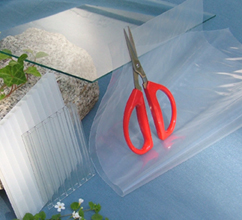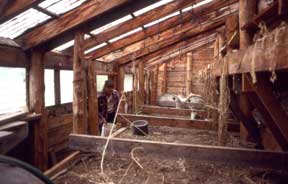
Choices in greenhouse glazing
 Choosing
the glazing for a greenhouse is one of the trickiest parts of the
design process. Most people choose thin sheets of
so-called greenhouse plastic, the cheapest of which you can often buy
locally at a hardware store. Unfortunately, Oehler reports that
this ultra-low-end plastic usually only lasts about a year. He
finds that the 6 mil, UV-treated plastic
available at greenhouse-specialty shops lasts a bit longer (up to four
years), but not
long enough to be worth the additional price.
Choosing
the glazing for a greenhouse is one of the trickiest parts of the
design process. Most people choose thin sheets of
so-called greenhouse plastic, the cheapest of which you can often buy
locally at a hardware store. Unfortunately, Oehler reports that
this ultra-low-end plastic usually only lasts about a year. He
finds that the 6 mil, UV-treated plastic
available at greenhouse-specialty shops lasts a bit longer (up to four
years), but not
long enough to be worth the additional price.
Moving into the more
expensive but more long-lived choices, there are
various types of rigid plastics you can use in greenhouses. None
of these plastics will last as long as glass since they slowly yellow
(blocking light) over time, and since scratches will speed up the
decline in
light penetration. On the other hand, rigid plastic is safer than
glass
(especially on roofs) because the plastic won't shatter, and plastic is
considerably lighter, making it easier to work with.
At the high end, acrylic
(aka plexiglass) lasts the longest (25 to 30
years) and gives you the best visibility if view is important to
you. Polycarbonate is a slightly cheaper choice, staying clear
for about a decade, or up to 35 years if you choose a version that's
been UV-treated. Oehler notes that he would probably choose
polycarbonate for future roofs.
 For the walls, Oehler is a
fan of scavenging old windows,
especially if
you can find double-strength B grade. Glass is much heavier than
plastics, which makes installation tougher, especially if you double
up windows to provide an insulated air space in between. But
windows
can often be found used or cheap, making them the lowest-cost building
option.
For the walls, Oehler is a
fan of scavenging old windows,
especially if
you can find double-strength B grade. Glass is much heavier than
plastics, which makes installation tougher, especially if you double
up windows to provide an insulated air space in between. But
windows
can often be found used or cheap, making them the lowest-cost building
option.
None of the glazing
options have spoken to me in the past, which is one of the big reasons
I've been anti-greenhouse. So I'm curious to hear from readers
who have experience with greenhouses. Which type of glazing did
you choose and how long did it last?
 This post is part of our Earth-Sheltered Solar Greenhouse lunchtime
series.
Read all of the entries: This post is part of our Earth-Sheltered Solar Greenhouse lunchtime
series.
Read all of the entries: |
Want more in-depth information? Browse through our books.
Or explore more posts by date or by subject.
About us: Anna Hess and Mark Hamilton spent over a decade living self-sufficiently in the mountains of Virginia before moving north to start over from scratch in the foothills of Ohio. They've experimented with permaculture, no-till gardening, trailersteading, home-based microbusinesses and much more, writing about their adventures in both blogs and books.
Want to be notified when new comments are posted on this page? Click on the RSS button after you add a comment to subscribe to the comment feed, or simply check the box beside "email replies to me" while writing your comment.

30 years plus on the glass in the family's greenhouse. Built out of used windows.
4 years plus on the twin-wall poly-carbonate for my "greenhouse" The triple-wall stuff is strong enough you can walk on it according to some, I've only sourced the twin-wall stuff. It's also the easiest stuff ever to work with. Cut with utility knife, tape with metal tape to seal the tubes. I use it as my winter window covers with ducttape "flaps" to seal the edges and give some room for expansion and contraction. I also like it for cold frames and "clotches" up against my house. I use conduit and plastic hoops for the garden beds but have just NEVER managed to attach plastic at an angle to the house and have it hold. The polycarbonate is an excellent solution - stiff enough, easily cut, drilled and tied down/anchored etc. Think nail hole plus zip-ties.
This is one of the few ways which I think modern plastics are oh so amazing and awesome and wonderful and perfect and... cannot say enough good about them and the use of poly-carbonate!! I know. Sorry. Am gushing.
@Pamina:
There are two types of treatment for modern low-emissivity glass;
The sputter coating blocks around 70% of UV radiation. The pyrolitic coating is not known for blocking UV.
Laminated glass however can block up to 99% of UV radiation.
There are glass types that maximize solar power transmission, e.g. Guardian's EcoGuard.
Of course recycling old window panes is always a good idea. But a modern low-e glass can help keep the greenhouse warmer.